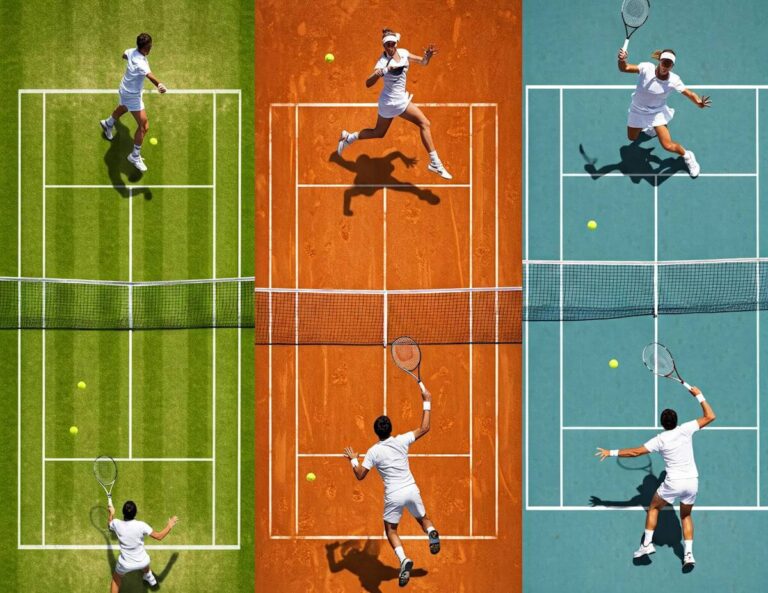Introduction to Playing Styles in Tennis
Tennis is a sport characterized by the diverse playing styles adopted by its elite athletes. Understanding these playing styles is crucial for analyzing the performances and strategies of top players. Each style possesses distinct tactics and techniques that can significantly influence match outcomes. The main categories of playing styles typically include baseline play, serve-and-volley, and all-court strategies, with players often specializing in one or blending multiple styles to suit their strengths.
Baseline players, as the name suggests, primarily engage in rallies from the back of the court. They tend to rely on solid groundstrokes and consistent shot placement to outlast their opponents. This style emphasizes endurance and control, with players often using heavy topspin and deep shots to push their rivals behind the baseline. Notable examples of baseline-centric players include Rafael Nadal and Novak Djokovic, who have mastered this approach through years of relentless practice and competitive experience.
In contrast, the serve-and-volley style is predicated on aggressive net play, where players attempt to win points by quickly moving towards the net after serving. This style demands exceptional reflexes and volleying skills, as well as strategic serve placement to set up the following shots. Players such as Pete Sampras and Roger Federer have achieved considerable success utilizing this approach, showcasing the effectiveness of swift net transitions.
All-court players exhibit versatility and adaptability, seamlessly transitioning between baseline and net play depending on the match situation. This style allows for a comprehensive utilization of various shots and techniques, making it difficult for opponents to predict the player’s next move. By understanding these individual playing styles, fans and analysts can gain deeper insights into players’ strategies, strengths, and weaknesses, thereby enriching the overall viewing experience in professional tennis.
The Baseline Game: Characteristics and Notable Players
The baseline game in tennis is characterized by players who primarily position themselves at the back of the court, engaging in rallies that showcase powerful groundstrokes and strategic ball placement. This style allows these players to control the tempo and direction of the match, relying not only on raw power but also on finesse and court awareness. The fundamental component of this playing style is the ability to hit consistent, deep shots that push opponents back and create opportunities for winners.
Notable players who have excelled at the baseline game include Rafael Nadal and Novak Djokovic, both of whom have redefined the baseline approach in modern tennis. Nadal, often referred to as the ‘King of Clay,’ utilizes heavy topspin and relentless determination to dominate from the back of the court. His unique playing style effectively exploits opponents’ weaknesses, while his athleticism allows him to chase down balls that would typically be considered out of reach. By engaging in long rallies, Nadal wears down his adversaries and creates openings for explosive shots that ultimately lead to points.
Similarly, Novak Djokovic exemplifies the effectiveness of the baseline game through his exceptional footwork and ability to anticipate shots. Djokovic’s all-court prowess enables him to execute a combination of powerful and precise groundstrokes, as well as tactical changes in rhythm, ensuring he is always a step ahead of his opponent. His phenomenal defensive skills, coupled with a remarkable return of serve, reinforce his standing as one of the top practitioners of the baseline style.
Through their distinctive characteristics, both Nadal and Djokovic illustrate the power and strategic depth of the baseline game. This style not only emphasizes physical capability but also underscores the importance of mental resilience in achieving success on the professional tennis circuit.
Serve-and-Volley: The Art of Aggressive Play
The serve-and-volley tactic is a distinctive playing style in tennis that emphasizes aggressive, offensive play. This approach involves a player serving the ball and immediately advancing towards the net, aiming to capitalize on the opponent’s return. The essence of serve-and-volley lies in the quick transitions between baseline and net play, leading to rapid points that can unsettle opponents and dictate the pace of the match. Historically, this strategy has been employed effectively by many top players, among whom Pete Sampras and Roger Federer have distinguished themselves.
Pete Sampras, known for his powerful serve and agile net game, exemplified the serve-and-volley style during his illustrious career. His serve consistently put pressure on opponents, often allowing him to dictate the point immediately after the serve. Once at the net, Sampras displayed exceptional volleying skills, often finishing points with a combination of powerful overheads and deft touch shots. However, relying heavily on the serve-and-volley strategy has its drawbacks; players who consistently employ this tactic may become vulnerable against those with strong passing shots, as the court coverage becomes essential when approaching the net.
Similarly, Roger Federer has made the serve-and-volley strategy a contemporary hallmark of his game, integrating it smoothly into his all-court play. While Federer is renowned for his baseline prowess, his ability to transition to the net and execute volleys with finesse has consistently troubled opponents. He utilizes this tactic particularly on faster surfaces, where his serve can create ideal conditions for agile play at the net. Nonetheless, like Sampras, Federer faces challenges when facing opponents who excel at targeting his feet or hitting deep passes, emphasizing the need for adaptability and strategic thinking when employing the serve-and-volley style.
All-Court Players: Versatility and Adaptability
All-court players are often celebrated in the realm of tennis for their remarkable ability to navigate various playing surfaces and adapt their strategies according to the match situation at hand. This versatility sets them apart from specialists who may excel primarily on either clay, grass, or hard courts. Noteworthy examples of all-court players include Andre Agassi and Ashleigh Barty, both of whom have demonstrated exceptional skills and strategic flexibility throughout their careers.
Andre Agassi, known for his baseline prowess, was equally adept at approaching the net, showcasing a blend of power and finesse. His ability to adjust his tactics in the midst of a match was instrumental in his success. For instance, during his illustrious career, Agassi transitioned from a defensive baseline style to an aggressive offensive approach, particularly effective on faster surfaces. This adaptability allowed him to secure numerous Grand Slam titles, demonstrating that an all-court game can be both complex and effective.
Similarly, Ashleigh Barty, who has made a significant impact on women’s tennis, exemplifies the all-court playing style with her seamless transitions between aggressive and defensive positions. Barty’s game is characterized by her strong serve, intelligent placement, and an impressive net game. She can adapt her style according to her opponent’s weaknesses and the demands of the match. Her performance on different surfaces—from grass at Wimbledon to clay at the French Open—underscores her versatility and strategic acumen.
In essence, all-court players like Agassi and Barty leverage their diverse skill sets to excel in varying conditions and challenges presented by their opponents. Their innate ability to read the game and make real-time adjustments reflects a masterful understanding of tennis, ultimately setting the tone for their ongoing success on the professional circuit.
Defensive Players: Mastering the Art of Counterplay
Defensive players have consistently showcased their ability to thrive in high-pressure situations, turning potential disadvantages into advantages through strategic counterplay. These players, often characterized by their exceptional anticipation and resilience, utilize a range of tactics that allow them to outlast opponents. Among the notable names in this arena are Andy Murray and Emma Raducanu, both of whom exemplify the attributes of effective defensive play.
Andy Murray, a former world number one, is widely regarded for his incredible defensive skills. His mental fortitude and agility on-court enable him to engage in prolonged rallies, frustrating aggressive players by returning balls with precision and placing them strategically. Murray’s game is built on a solid foundation of speed, allowing him to position himself optimally and counter opponent attacks effectively. Through relentless training and adaptability, he has mastered the art of counterplay, often transforming defensive scenarios into offensive opportunities, demonstrating that strong defensive strategies can lead to significant advantages.
Similarly, Emma Raducanu has emerged as one of the leading defensive players on the WTA tour. Despite her relatively short professional career, her agility and poise under pressure have proven crucial in her gameplay. Raducanu excels at constructing points, often luring her opponents into making mistakes. By maintaining focus and employing a thoughtful approach, she has showcased her ability to counter aggressive styles effectively. Her knack for turning the tide in challenging match situations remains a testament to her defensive capabilities.
The success of these players highlights the importance of mental strength and strategic thinking in tennis. Both Murray and Raducanu exemplify how defensive skills, combined with determination, can lead to impressive outcomes, serving as a reminder that counterplay does not merely consist of extended rallies, but rather a blend of skill, intelligence, and unwavering focus.
Aggressive Baseliners: Power and Precision
Aggressive baseliners represent a dynamic playing style in the world of tennis, characterized by a blend of power and pinpoint precision. Players who embody this style often dictate the flow of the match from the baseline, leveraging their strength to put pressure on opponents while maintaining control over shot placement. Among the standout aggressive baseliners are Dominic Thiem and Aryna Sabalenka, both of whom have demonstrated remarkable prowess on the court.
Dominic Thiem, an Austrian professional tennis player, has emerged as a formidable force in men’s tennis, particularly known for his powerful groundstrokes and relentless attacking mentality. His ability to generate high levels of topspin and pace allows him to dominate rallies, forcing opponents into defensive positions. Thiem’s aggressive baseline play is complemented by his tactical awareness; he often anticipates his opponent’s moves, enabling him to strike with precision at critical moments. This combination of power and strategic shot placement is key to his success, allowing him to dictate points and secure important victories.
Aryna Sabalenka, a prominent figure in women’s tennis, shares a similar aggressive playing style. Known for her heavy hitting, Sabalenka frequently imposes her will on matches through forceful baseline strikes. Her precision in shot placement enhances her gameplay, ensuring that her powerful shots not only land deep in the opponent’s court but also exploit any weaknesses in their defense. Sabalenka’s physicality and mental fortitude make her a formidable opponent, as she can transition from defense to offense in the blink of an eye, showcasing her ability to control the tempo of the match.
The effectiveness of aggressive baseliners like Thiem and Sabalenka highlights the importance of combining power with accuracy. This synergy allows them to outmaneuver opponents, establishing their dominance and ultimately shaping match outcomes in their favor.
Comparison of Playing Styles: Impact on Match Outcomes
The diverse playing styles exhibited by tennis professionals can significantly influence match outcomes. Understanding these stylistic differences provides insight into the nuances of the game and can elucidate why certain players excel in particular matchups. Generally, players can be categorized into several styles: aggressive baseliners, serve-and-volley specialists, defensive counterpunchers, and all-court players, each possessing unique strengths and weaknesses.
Statistical data indicates that aggressive baseliners, who favor powerful groundstrokes and dictating play from the back of the court, tend to dominate matches when effective. For instance, during the 2023 Australian Open, a notable confrontation between two leading baseliners resulted in a match riddled with remarkable rallies, showcasing their ability to sustain long exchanges, ultimately favoring the player who maintained greater consistency under pressure. In contrast, serve-and-volley players, who capitalize on their serves and rush the net, often find success on faster surfaces, as evidenced in certain Wimbledon matches, where rapid point accumulation can thwart an opponent’s rhythm.
Moreover, defensive players adept at counterpunching utilize their opponent’s aggression against them, often making the match more of a psychological battle. This was prominently displayed in a recent semi-final where a top-ranked counterpuncher successfully neutralized an aggressive opponent’s power play through strategic shot selection and court coverage. The clash of styles not only influences the match pace but also impacts players’ mental fortitude, frequently leading to unexpected upsets when the perceived underdog effectively adapts their game.
Furthermore, the all-court player, who seamlessly transitions between styles, can exploit the weaknesses of both offensive and defensive opponents. As demonstrated during the recent US Open, an all-court player’s versatility allowed them to dominate matches against both types of competitors, showcasing adaptability as a crucial component in achieving success. Such compelling examples highlight the essential role that playing styles play in determining match results and the intricate dynamics that unfold during high-stakes competitions.
Adaptation of Playing Styles Over Time
Tennis has undergone significant evolution since its inception, particularly with regards to playing styles. Historically, players relied on a more classical approach, utilizing well-timed volleys and precise strokes. However, the last few decades have witnessed a transformation influenced by advancements in training methodologies, tennis equipment, and the diversity of court surfaces. Modern players now have the ability to adapt these classic styles to meet the specific demands of the contemporary game.
One critical factor contributing to this shift is the technology behind racquets. Today’s racquets are engineered with advanced materials that provide enhanced power and control, permitting players to hit the ball with greater speed and spin. For instance, consider how Roger Federer has effectively integrated a classic one-handed backhand while employing modern techniques to increase both his aggressiveness and finesse. His adaptability has allowed him to dominate matches on various surfaces, showcasing how traditional styles can be effectively modernized.
Additionally, the different playing surfaces, such as hard courts, clay, and grass, have prompted players to modify their styles accordingly. The slow pace of clay courts necessitates patient baseline rallies, as seen in players like Rafael Nadal, who has mastered the art of constructing points meticulously. Conversely, the quick bounce on grass courts favors serve-and-volley strategies, which has revived elements reminiscent of the game’s earlier eras. Players such as Novak Djokovic exemplify this versatility, capable of executing powerful baseline shots while still remaining adept at net play.
Furthermore, training regimens have become more specialized, focusing on aspects like physical fitness, mental resilience, and tactical awareness. The incorporation of analytics has allowed players to understand their opponents’ weaknesses and adjust their strategies, reflecting a blend of classic and modern strokes. In essence, the evolution of playing styles in tennis is a compelling narrative of how historical techniques have been refined to meet the rigorous demands of today’s game, with present-day players continuously reshaping these traditions to carve their unique paths.
Conclusion: The Significance of Understanding Playing Styles
In the realm of tennis, the various playing styles employed by athletes significantly influence the dynamics of the game. By analyzing these styles, one can gain deeper insights into player development, match predictions, and formal appreciation of the sport. Recognizing the nuanced strategies that top players utilize not only enriches the viewer’s experience but also informs aspiring athletes and coaches on effective training methodologies.
Playing styles can broadly be categorized into power, control, all-court, and serve-and-volley strategies. Each of these styles embodies distinct attributes and techniques that define how a player approaches the match. For example, power players often rely on aggressive shots to dominate rallies, while control players focus on precision and placement to outmaneuver their opponents. Understanding these variations allows fans to appreciate the intricacies of each match, leading to a more engaged viewing experience as they anticipate the outcomes of different strategies.
Furthermore, analysis of playing styles enables stakeholders—coaches, analysts, and players themselves—to tailor training programs that enhance individual strengths and address weaknesses. Emphasizing specific skills associated with a player’s style can facilitate accelerated development and performance improvement. Moreover, this understanding aids in making informed predictions regarding match outcomes, as certain styles may have inherent advantages against others depending on the players involved.
As the sport continues to evolve, the significance of understanding playing styles cannot be overstated. In the future, it may be intriguing to observe how emerging players adapt traditional techniques or create hybrid styles that challenge established norms. The ongoing analysis of these evolving tendencies will provide valuable insights while shaping the anticipation surrounding upcoming tournaments and matches across all levels of competition.



